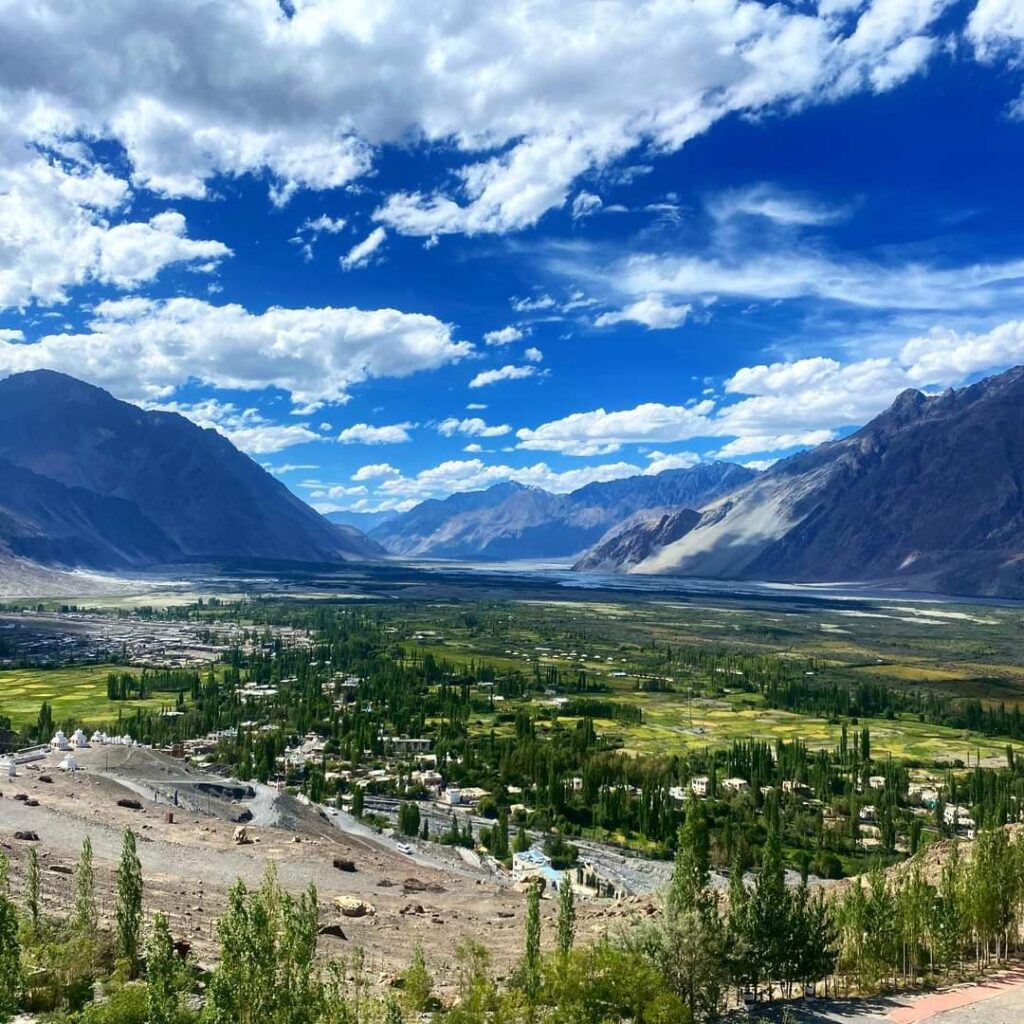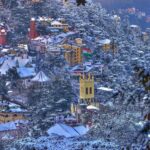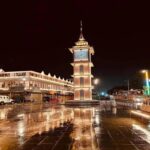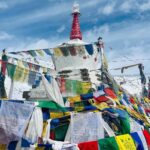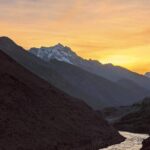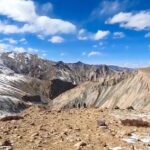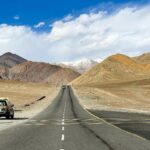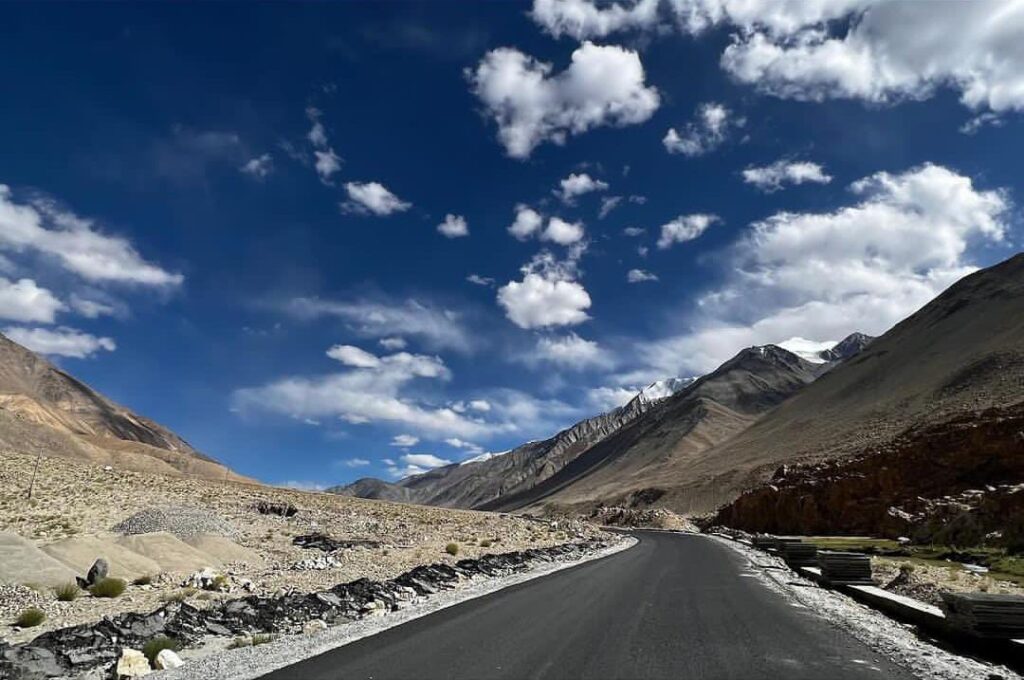
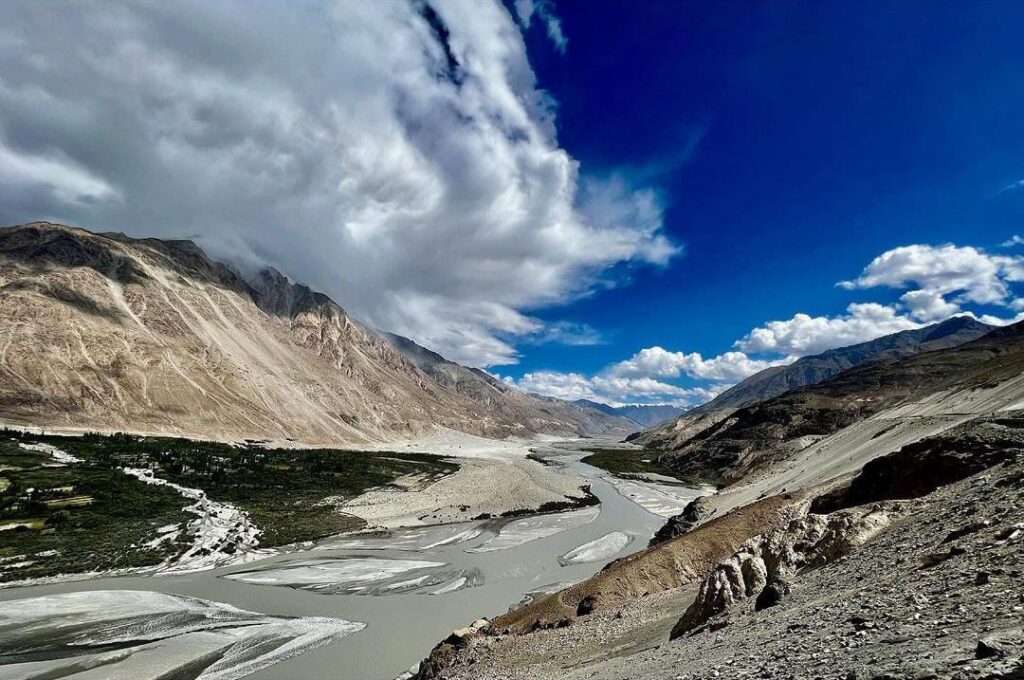
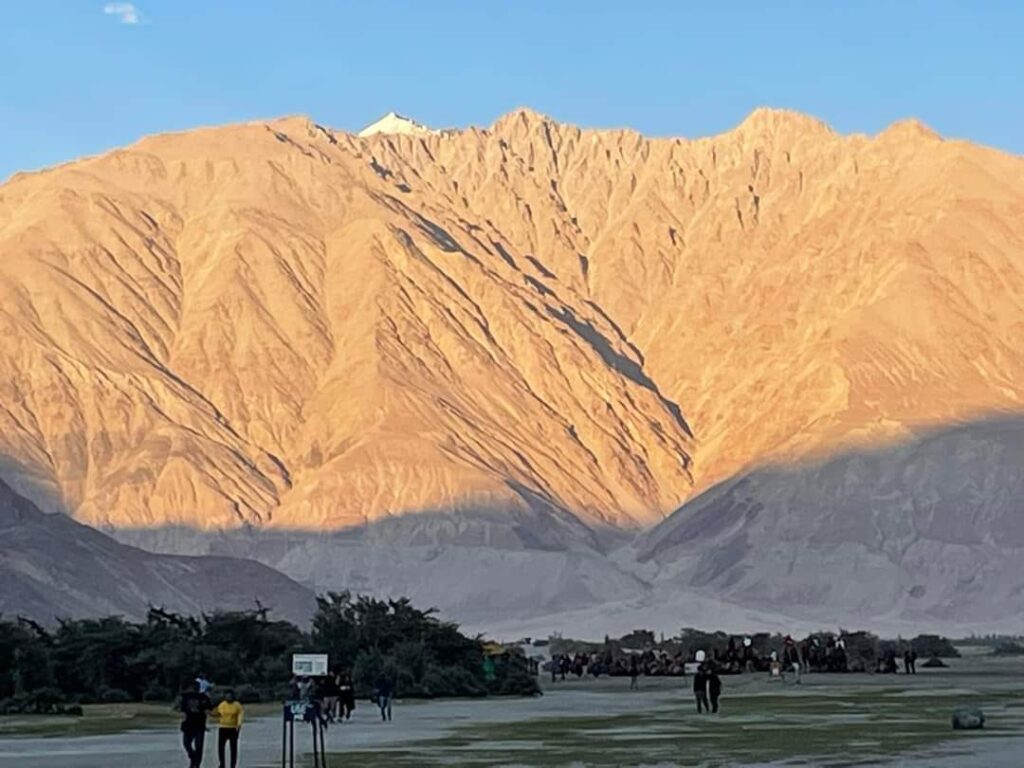
Nubra valley
The northernmost region of India is where Nubra Valley is located. The Ladakh region is decorated with the breathtaking natural beauty of Nubra Valley, a captivating jewel. This secluded and beautiful valley is known for its striking topography, which includes towering sand dunes, lush green oasis settlements, and rough mountains, all against the mesmerizing background of the powerful Karakoram Range.
Perched at an elevation of approximately 10,000 feet above sea level, Nubra Valley stands as a testament to nature’s artistry, offering a unique blend of arid desert terrain and verdant meadows, nurtured by the life giving waters of the Nubra and Shyok rivers. This remote valley is not only a visual spectacle but also a gateway to ancient monasteries, Tibetan culture, and a thriving community that welcomes visitors with open arms.
Its unparalleled beauty and serene tranquility make Nubra Valley a must visit destination for those seeking a taste of Ladakh’s rugged charm and natural splendor. As you venture into this captivating realm, prepare to be captivated by the symphony of contrasts that unfolds before your eyes. The starkness of the desert gives way to verdant oases, while towering peaks stand sentinel over tranquil villages. The air is imbued with a sense of mysticism, as ancient monasteries whisper tales of a bygone era.
In Nubra Valley, time seems to slow down, allowing you to immerse yourself moving to the beat of life as it has been lived for centuries. Explore the narrow lanes of villages, adorned with colorful prayer flags, and engage in heartfelt conversations with locals who want to spread the word about their rich cultural heritage. Take adventurous hikes across stunning scenery or just unwind and take in the tranquility of this lovely valley.
Nubra Valley is a place where nature reigns supreme, offering a glimpse into the raw beauty of the Himalayas. It is a destination that will leave an indelible mark on your soul, long after you have departed from its embrace.
Name and Geography of Nubra valley
Nubra is known locally as “Dumra,” which is Arabic for “the valley of flowers.” In contrast, Nubra in Ladakhi means “western,” alluding to the western Valley of Nubra as distinct from the sparsely inhabited eastern valley.
The Siachen Glacier is located to the north of Nubra, a high-altitude, freezing desert, and the Karakoram Pass is located to the northwest of the valley. Due to the region’s extremely low rainfall, only the river banks have limited vegetation. The residents grow a variety of crops, including apples, apricots, walnuts, and almonds, as well as grains like barley, wheat, and mustard, thanks to the rivers’ ability to irrigate and fertilize the area.
History of nubra valley
The history of Nubra Valley is unknown in mystery and myth. However, it is known that the valley has been inhabited for centuries by various peoples, including the Mon, Dards, and Tibetans.
In the 7th century, Buddhism was introduced to Nubra Valley, and it soon became a major center of Buddhist learning. The valley was home to several important monasteries, including the Diskit Gompa, which was founded in the 14th century.
In the 16th century, Nubra Valley came under the control of the Namgyal dynasty of Ladakh. The Namgyal kings ruled the valley for centuries, and they were responsible for building many of the valley’s most important structures, including the Hundar Palace.
In the 19th century, Nubra Valley became a part of the British Raj. The British were interested in the valley’s strategic location, and they built a number of forts and roads in the area.
In 1947, Nubra Valley became a part of India. The valley has since been a popular tourist destination, and it is known for its stunning natural beauty and its rich cultural heritage.
Some of the key events in the history of Nubra Valley include:
- 7th century: Introduction of Buddhism to Nubra Valley
- 14th century: Founding of Diskit Gompa
- 16th century: Nubra Valley comes under the control of the Namgyal dynasty of Ladakh
- 19th century: Nubra Valley becomes a part of the British Raj
- 1947: Nubra Valley becomes a part of India
Things to do in nubra valley
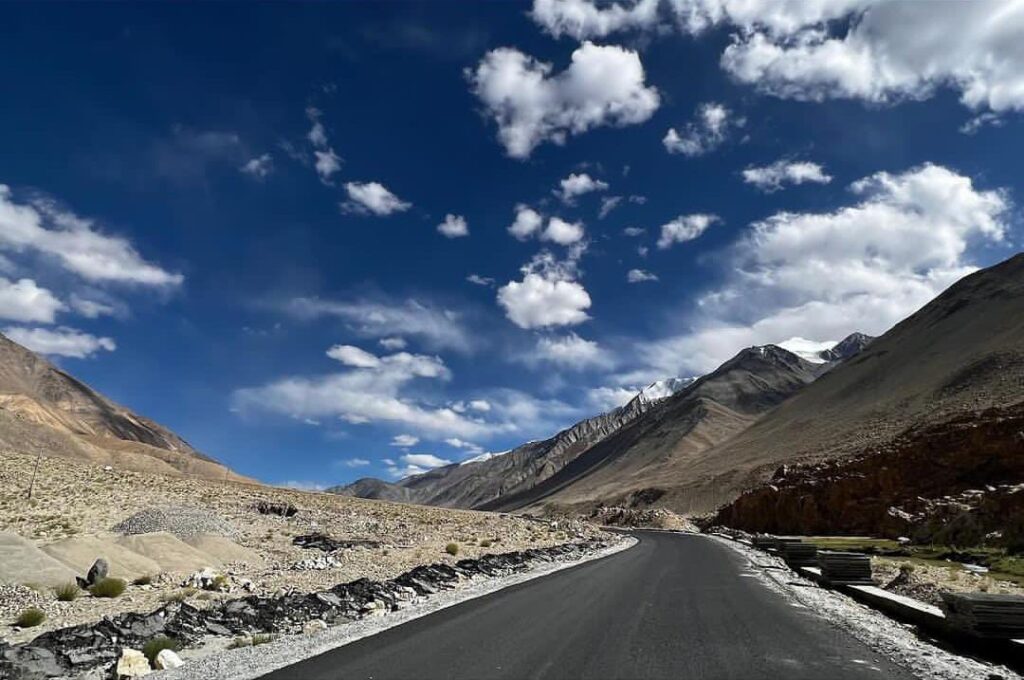
Nubra Valley in Ladakh is a paradise for nature lovers and adventure seekers, offering a wide range of activities to enjoy its stunning landscapes and rich culture. Here are some things to do in Nubra Valley, along with explanations:
Camel Safari in Hunder: Experience a unique camel safari in the sand dunes of Hunder. These safaris are usually conducted on Bactrian camels, which are known for their double humps. It’s a fantastic way to explore the desert-like terrain and take in the breathtaking views of the valley.
Visit Diskit Monastery: Explore the historic Diskit Monastery, one of the oldest and largest monasteries in Nubra Valley. Learn about Tibetan Buddhism, admire the stunning architecture, and take in the panoramic views of the valley from its location.
Trekking: Nubra Valley offers a variety of trekking routes, including the popular trek to the Turtuk village and beyond. Treks vary in difficulty and duration, making it accessible to both beginners and experienced trekkers. You can enjoy the serene landscapes and the culture of remote villages along the way.
Panamik Hot Springs: Soak in the natural hot springs of Panamik. These geothermal springs are known for their healing properties and offer a relaxing experience amidst the mountainous surroundings.
Visit Turtuk: Turtuk is a picturesque village located near the Line of Control (LoC) with Pakistan. It provides a unique opportunity to interact with Balti people, experience their culture, and savor authentic Balti cuisine.
Photography: Nubra Valley is a photographer’s paradise. The striking contrast between the desert sand dunes, the green valleys, and the snow-capped peaks provides endless opportunities for capturing stunning landscapes and cultural moments.
Stargazing: Due to its remote location and high altitude, Nubra Valley offers excellent conditions for stargazing. Clear night skies provide a chance to witness a blanket of stars and even the Milky Way.
Explore Local Villages: Take time to visit the charming villages scattered throughout the valley. Interact with the welcoming locals, learn about their way of life, and enjoy traditional Ladakhi hospitality.
Attend Festivals: If your visit coincides with local festivals, don’t miss the chance to participate in the vibrant celebrations. Festivals like the Dosmoche and Diskit Gustor offer a glimpse into the rich cultural traditions of the region.
Motorbiking: For thrill-seekers, Nubra Valley offers excellent motorbiking opportunities. The rugged terrain and scenic landscapes make it a popular destination for motorbike enthusiasts.
When visiting Nubra Valley, it’s important to be mindful of the environment and local customs, and always check the current travel regulations, especially if you are traveling from Leh, as permits may be required due to its proximity to sensitive border areas.
Best time visit Nubra Valley in Ladakh
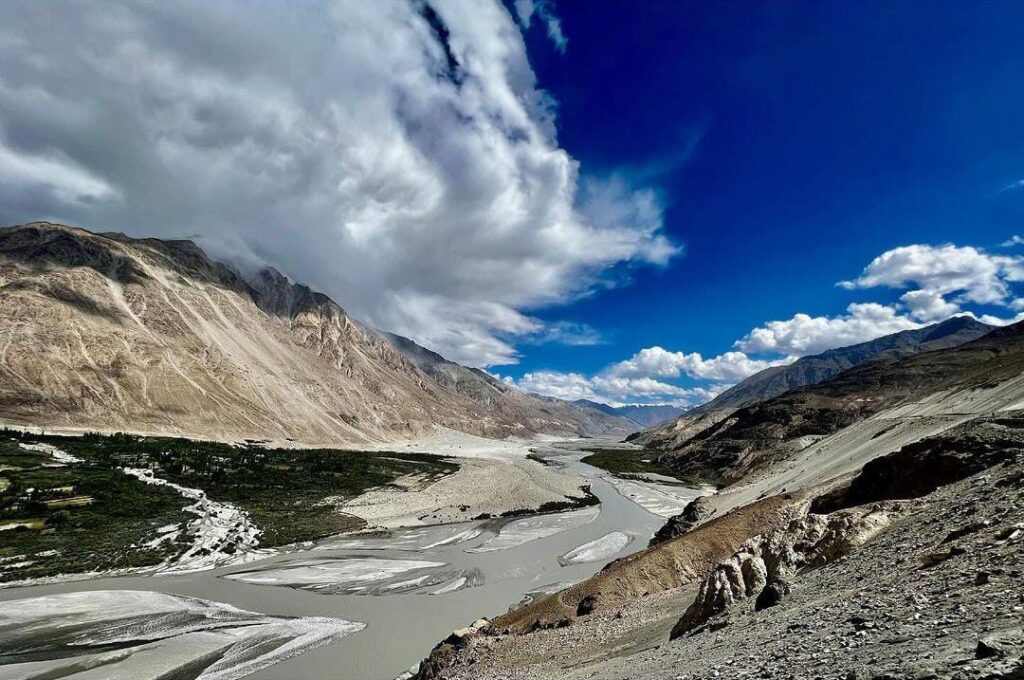
The best time to visit Nubra Valley in Ladakh largely depends on your preferences and the type of experiences you seek. Nubra Valley experiences extreme weather conditions due to its high-altitude location, so the ideal time to visit can vary. Here are the main considerations for each season:
Summer (June to September):
- Best for: Most tourists prefer to visit Nubra Valley during the summer months.
- Weather: The weather is pleasant, with daytime temperatures ranging from 20°C to 25°C (68°F to 77°F).
- Lush Greenery: This is the time when the valley is at its greenest, with vibrant vegetation and blooming flowers.
- Clear Roads: Roads are generally clear, and most areas are accessible during this time, including high mountain passes like Khardung La.
- Festivals: If you visit in August or September, you may have the chance to witness local Ladakhi festivals.
Autumn (October to November):
- Best for: Travelers who prefer fewer crowds and milder weather.
- Weather: The temperatures start to drop, and daytime temperatures can range from 10°C to 20°C (50°F to 68°F).
- Landscape: The landscapes remain stunning with the changing colors of fall, and the clear skies are ideal for photography.
- Peaceful: It’s less crowded than the summer months, offering a more peaceful experience.
Winter (December to February):
- Best for: Adventurous travelers looking for a unique winter experience.
- Weather: Winter in Nubra Valley is extremely cold, with temperatures often dropping well below freezing. Snowfall is common.
- Unique Experience: If you’re interested in experiencing the valley covered in a blanket of snow and engaging in winter activities, this is the time to go.
- Limited Access: Many roads and accommodations may be closed or have restricted access, so travel plans should be made carefully.
Spring (March to May):
- Best for: Visitors interested in witnessing the region’s transformation from winter to spring.
- Weather: Spring in Nubra Valley sees gradually rising temperatures, with daytime highs ranging from 10°C to 20°C (50°F to 68°F).
- Landscape: The snow begins to melt, revealing lush green fields, and apricot and almond trees blossom, creating picturesque landscapes.
- Access: Road conditions may still be challenging early in the season, so check for accessibility before planning your trip.
The best time to visit Nubra Valley depends on your personal preferences and the kind of experience you desire. If you enjoy milder weather and lush greenery, the summer months are ideal. For a unique winter adventure, consider the winter season. Spring and autumn offer a balance between comfortable weather and picturesque landscapes with fewer tourists. Make sure to check current road conditions and accessibility when planning your visit.
Tips for visitors to visit nubra valley
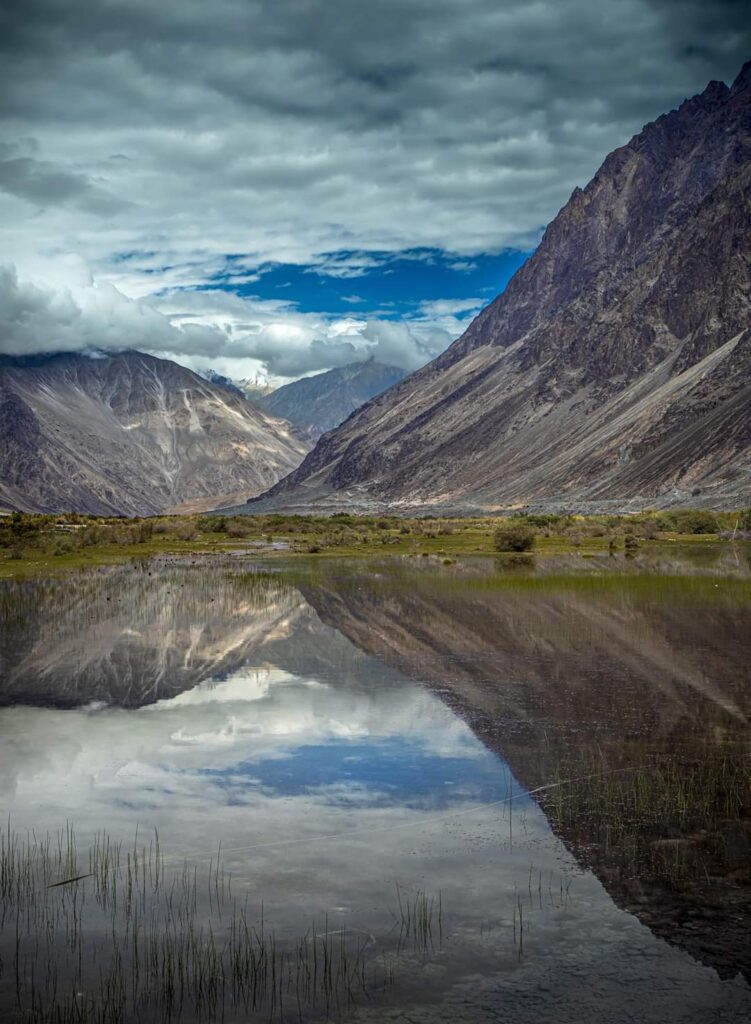
Visiting Nubra Valley in Ladakh is a unique and exciting experience, but it’s essential to be well prepared to make the most of your trip. Here are some tips for visitors, along with explanations:
Acclimatization: Ladakh is at high altitude, and altitude sickness is a real concern. It’s crucial to spend a day or two in Leh or another lower-altitude location to acclimatize before heading to Nubra Valley. This helps your body adjust to the reduced oxygen levels and reduces the risk of altitude-related health issues.
Travel Permits: Ensure you have the necessary permits to visit Nubra Valley. These permits are usually obtained in Leh and may be checked at various checkpoints on the way to Nubra, especially in sensitive border areas. Make sure you have multiple photocopies of your permits.
Cash: There are limited ATMs in Nubra Valley, and they may not always be functioning. It’s wise to carry enough cash to cover your expenses, especially if you plan to visit remote villages.
Pack Wisely: The weather in Nubra Valley can be unpredictable. Be prepared for both hot and cold weather. Dress in layers and include warm clothing, as temperatures can drop significantly at night.
Stay Hydrated: The high altitude can lead to dehydration. Drink plenty of water to stay hydrated, but also be mindful of your water source. It’s advisable to carry a reusable water bottle and use filtered or bottled water.
Respect Local Culture: Ladakh has a rich cultural heritage, primarily Tibetan Buddhism. Be respectful when visiting monasteries, stupas, and interacting with locals. Ask for permission before snapping pictures of individuals and take off your shoes before entering places of worship.
Waste Management: Ladakh is a fragile ecosystem, and proper waste disposal is essential. Carry a reusable garbage bag and dispose of your waste properly, either in designated bins or by taking it back with you to Leh.
Phone and Internet: Mobile phone coverage can be unreliable in Nubra Valley, and internet access may be limited. Inform your loved ones of your itinerary and stay connected when possible. It’s also advisable to download offline maps for navigation.
Altitude Medication: Consider carrying medications for altitude sickness, such as Diamox. Consult a healthcare professional before your trip, and take the medication as prescribed if you experience symptoms of altitude sickness.
Plan Accommodation: It’s advisable to book your accommodation in advance, especially during peak tourist season. Nubra Valley offers a range of options, from guesthouses to luxury camps, but availability can be limited.
By following these tips, you can have a more enjoyable and safe visit to Nubra Valley, taking in its stunning natural beauty and immersing yourself in the unique Ladakhi culture. It’s essential to respect the local environment and traditions while being prepared for the challenges of high-altitude travel.
Nubra valley weather and nubra valley temperature
The weather in Nubra Valley is cold and dry for most of the year. The summer months (June to August) are the warmest, with average temperatures ranging from 15 to 25°C. The winter months (December to February) are the coldest, with average temperatures ranging from -15 to -5°C. Rainfall is scarce throughout the year, with an average annual rainfall of only 150 mm.tunesharemore_vert
| Month | Average Temperature (°C) | Average Rainfall (mm) |
| January | -15 to -5 | 30 |
| February | -10 to -0 | 25 |
| March | -5 to 5 | 20 |
| April | 0 to 10 | 15 |
| May | 5 to 15 | 10 |
| June | 10 to 20 | 5 |
| July | 15 to 25 | 0 |
| August | 15 to 25 | 0 |
| September | 10 to 20 | 5 |
| October | 5 to 15 | 10 |
| November | 0 to 10 | 15 |
| December | -5 to 5 | 20 |
Nubra valley altitude
The average altitude of Nubra Valley is 3,000 meters (10,000 feet) above sea level. The highest point in the valley is Khardung La pass, which is at an altitude of 5,359 meters (17,582 feet)
Nubra valley height in feet
The height of Nubra Valley in feet is 10,000 feet.
Nubra valley to pangong lake
It takes 7 hours 24 minutes to drive from Nubra Valley to Pangong Lake. The distance is 274 km. You can see the directions here.
Here are some tips for driving to Pangong Lake:
- Start early in the morning to avoid the crowds.
- The road is in good condition, but it is narrow and winding in some places. Drive slowly and carefully.
- Be aware of the high altitude. Pangong Lake is located at an altitude of 4,350 meters (14,270 feet). Altitude sickness can occur if you ascend too quickly. Drink plenty of fluids and avoid strenuous activity for the first few hours after arriving at the lake.
- The weather in the mountains can change quickly. Be prepared for cold temperatures, even in the summer.
- There are no gas stations or restaurants between Nubra Valley and Pangong Lake. Make sure you have a full tank of gas and enough food and water for the journey.
Nubra valley is famous for
- Breathtaking Landscapes: Nubra Valley is celebrated for its awe-inspiring landscapes, characterized by a unique blend of stark desert terrains, lush greenery, and dramatic mountain backdrops. The valley’s beauty is truly mesmerizing.
- Hunder Sand Dunes: The sand dunes in Hunder are a remarkable feature and a major attraction. Visitors can enjoy camel safaris on the Bactrian camels (known for their double humps) through these sand dunes, creating a desert-like experience within the Himalayas.
- Diskit Monastery: The Diskit Monastery, perched on a hilltop, is one of the oldest and largest monasteries in the region. It’s famous for its stunning architecture, serene ambiance, and the remarkable 32-meter Maitreya Buddha statue that overlooks the valley.
- Cultural Heritage: Nubra Valley is a hub of Ladakhi culture, particularly influenced by Tibetan Buddhism. Visitors can explore ancient monasteries, engage with local communities, and witness cultural festivals that offer a glimpse into the unique traditions of the region.
- Trekking and Adventure: The valley provides numerous trekking opportunities for adventurers, with trails leading to picturesque villages and high-altitude passes. The challenging yet rewarding treks showcase the raw beauty of the region.
- Nubra River and Shyok River: The Nubra and Shyok rivers flow through the valley, providing vital water resources for agriculture and adding to the picturesque landscapes. These rivers are a crucial aspect of the valley’s appeal.
- Panamik Hot Springs: Panamik, a village in Nubra, is famous for its natural hot springs. Travelers often visit these hot springs to relax and enjoy the therapeutic benefits of the warm waters.
- Stargazing: Nubra Valley’s remote location and high altitude offer clear, unpolluted skies that make it a fantastic destination for stargazing. Visitors can revel in the brilliance of the night sky and witness celestial wonders.
- Unique Flora and Fauna: The valley is home to diverse flora and fauna, including rare species such as the elusive snow leopard. Birdwatching and wildlife spotting are activities enjoyed by nature enthusiasts.
- Hospitality and Warmth: Nubra Valley is known for the warm hospitality of its residents. Visitors are welcomed with open arms and have the opportunity to experience Ladakhi culture firsthand through homestays and interactions with the locals.
Nubra Valley’s unique combination of natural beauty, cultural heritage, adventure, and serenity makes it a standout destination in the region, drawing travelers from around the world.
Nubra valley in which state
Nubra Valley is located in the Ladakh union territory of India. It is situated in the northernmost part of Ladakh, between the Karakoram Range and the Ladakh Range of the Himalayas.
what to do in nubra valley
Nubra Valley in Ladakh offers a range of activities and experiences to make the most of your visit. Here’s a list of things to do in Nubra Valley:
- Camel Safari in Hunder: Take a camel ride on the Bactrian (double-humped) camels through the Hunder Sand Dunes, offering a unique desert-like experience amidst the Himalayas.
- Visit Diskit Monastery: Explore the historic Diskit Monastery, known for its stunning architecture and a 32-meter Maitreya Buddha statue that provides panoramic views of the valley.
- Trekking: Enjoy trekking in the region. Popular treks include those to Turtuk, Panamik, and remote villages like Sumur. The treks offer an opportunity to experience local culture and stunning landscapes.
- Panamik Hot Springs: Soak in the natural hot springs of Panamik for relaxation and to experience the therapeutic benefits of the warm waters.
- Explore Local Villages: Interact with the welcoming locals and experience their way of life. Villages like Hunder, Diskit, and Turtuk offer insight into the Ladakhi culture.
- Nubra River and Shyok River: Take a leisurely stroll along the banks of the Nubra and Shyok rivers, enjoying the tranquil surroundings and the sound of flowing water.
- Photography: Capture the valley’s stunning landscapes and unique cultural moments. The stark contrast between the desert sand dunes and lush greenery makes for excellent photography.
- Stargazing: The clear night skies in Nubra Valley are perfect for stargazing. Gaze at the stars and, if you’re lucky, you might even spot the Milky Way.
- Local Cuisine: Savor traditional Ladakhi cuisine. Try dishes like momos (dumplings), thukpa (noodle soup), and butter tea for an authentic taste of the region.
- Visit Turtuk: Explore the picturesque village of Turtuk, known for its scenic beauty and the unique Balti culture. Interact with locals, visit historic sites, and enjoy the stunning surroundings.
- Attend Festivals: If your visit coincides with local festivals, immerse yourself in the vibrant celebrations. Events like Dosmoche and Diskit Gustor offer insights into Ladakh’s rich cultural traditions.
- Motorbiking: For adventure enthusiasts, consider a motorbike ride in the region. The rugged terrain and stunning landscapes make it a popular destination for motorbike trips.
- Tso Moriri and Tso Kar: Consider taking a side trip to the Tso Moriri and Tso Kar lakes, which offer a serene environment surrounded by barren mountains and are excellent for birdwatching and photography.
- Leisure and Relaxation: Finally, simply take some time to unwind and soak in the natural beauty of the valley. Enjoy the tranquility and serenity of this remote location.
Nubra Valley’s diverse attractions cater to a wide range of interests, from adventure seekers to cultural enthusiasts and nature lovers. Make sure to plan your visit well, taking into account the weather and travel conditions, and enjoy the unique charm of this region in Ladakh.
what to see in nubra valley
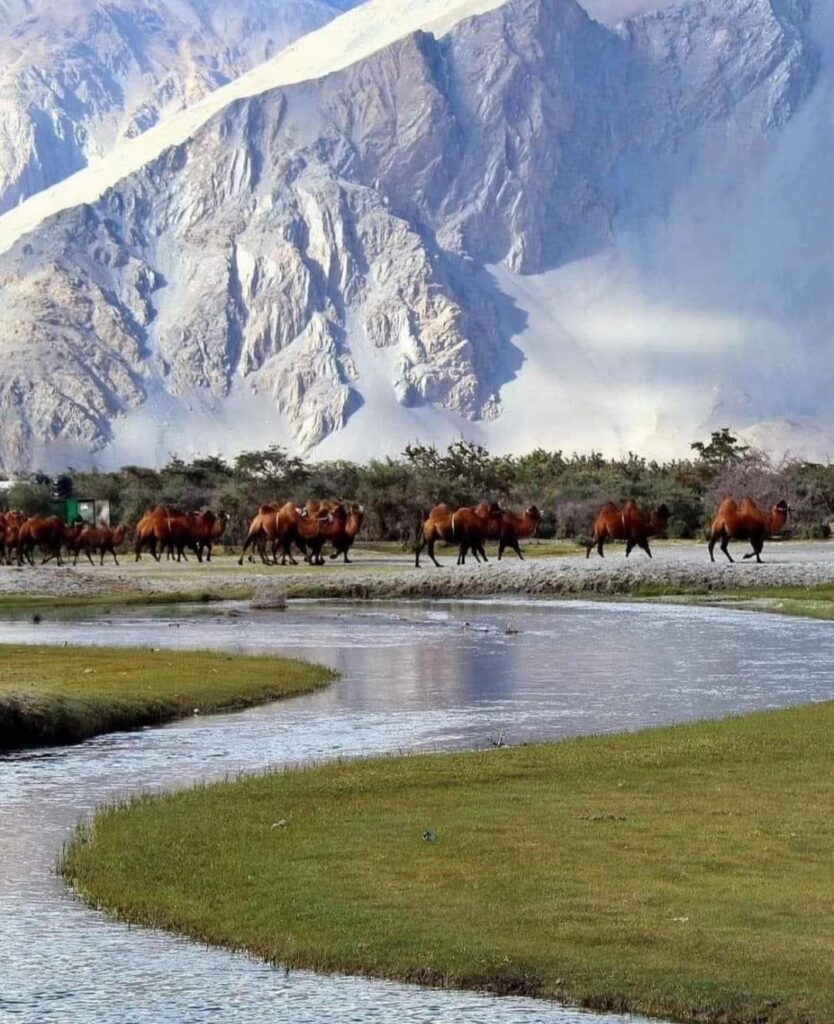
Nubra Valley in Ladakh is a region with a diverse array of attractions, ranging from natural wonders to cultural sites. Here’s a list of what to see in Nubra Valley:
- Hunder Sand Dunes: The sand dunes in Hunder are a must-see, offering a unique desert experience within the Himalayas. Enjoy camel safaris here for a memorable adventure.
- Diskit Monastery: Explore the Diskit Monastery, a prominent religious site in the valley. It houses a 32-meter-tall statue of Maitreya Buddha and offers panoramic views of the surroundings.
- Turtuk Village: Visit the picturesque village of Turtuk, renowned for its stunning beauty and the unique Balti culture. Take in the stunning landscapes and interact with locals.
- Bactrian Camels: Marvel at the Bactrian camels with their distinctive double humps, a rare sight in the region. You can see and ride these camels in Hunder.
- Panamik Hot Springs: Visit Panamik to experience the natural hot springs, renowned for their healing properties. A relaxing soak in these hot springs can be a great way to unwind.
- Nubra River and Shyok River: Enjoy the serene views along the banks of the Nubra and Shyok rivers. These rivers are vital to the region’s agricultural activities and provide tranquil settings.
- Tibetan Buddhist Monasteries: Explore the various monasteries in the valley, such as Diskit Monastery, Sumur Monastery, and more, to gain insights into the local culture and spirituality.
- Local Villages: Take time to explore local villages, including Diskit, Hunder, Sumur, and Turtuk, to appreciate the Ladakhi way of life, interact with residents, and savor authentic cuisine.
- Yarab Tso Lake: Visit this serene lake near the village of Panamik. The landscape around the lake is spectacular and perfect for photography.
- Cultural Festivals: If your visit coincides with local festivals such as Dosmoche or Diskit Gustor, it’s a unique opportunity to witness traditional Ladakhi celebrations and cultural performances.
- Stargazing: Enjoy the clear night skies for stargazing. The remote location of Nubra Valley offers excellent conditions for observing celestial wonders.
- Cold Deserts of Ladakh: The entire Nubra Valley is often referred to as the “Cold Desert of Ladakh.” The unique landscape, with its stark desert features and lush green pockets, is a sight to behold.
- Nubra Valley Wildlife: Keep an eye out for wildlife, such as the elusive snow leopard and various bird species, as the valley is home to a variety of fauna.
- Mountain Passes: While en route to Nubra Valley, you’ll cross high mountain passes like Khardung La, which offer spectacular views of the surrounding peaks.
These attractions combine to make Nubra Valley a destination that offers natural beauty, cultural richness, and unique experiences in the heart of the Himalayas.
what is nubra valley
Nubra Valley is a stunning and remote region located in the northernmost part of the Indian union territory of Ladakh, in the state of Jammu and Kashmir. It is nestled at an altitude of approximately 10,000 feet (3,048 meters) above sea level and is renowned for its extraordinary natural beauty, unique landscapes, and vibrant cultural heritage. Some of the key features of Nubra Valley include:
- Diverse Landscape
- Rivers
- Cultural Significance
- Unique Wildlife
- Bactrian Camels
- Scenic Passes
- Unique Villages
- Stargazing
Discover the Magic of Kashmir’s Natural Beauty in Our New Blog – An Adventure You Can’t Miss! THIKSEY MONASTERY , LEH ~ LADAKH , SHANTI STUPA , LEH PALACE
